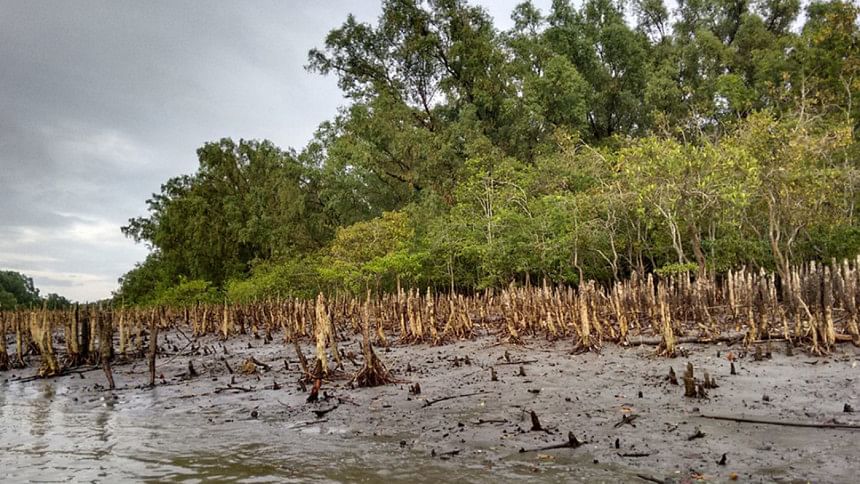Speakers raise concerns on Sundarbans Day

The Sundarbans, the world's largest mangrove forest, has long served as a shield for coastal communities, protecting them from natural disasters like cyclones and tidal surges. People in the coastal region have been observing February 14 Valentine's Day as "Sundarbans Day" to recognise this invaluable ecosystem. This year marks the 25th anniversary of the occasion.
Various programmes are being held throughout the day in 17 sub-districts of Khulna, Satkhira, Bagerhat, Pirojpur, and Barguna, which are considered impact zones of the Sundarbans. These activities include awareness rallies, discussions, art competitions, cycling rallies, signature campaigns, human chains, and photography contests.
This year's theme is: "Love the Sundarbans on Valentine's Day." The main event is being held at the Khulna Press Club, where representatives from the district administration, the forest department, and environmental organisations will participate.
Although the government has declared a 10-kilometer radius around the Sundarbans as an "Ecologically Critical Area" (ECA), over the past decade, at least 60 heavy industries have been established in this zone. These include cement factories, LP gas plants, oil refineries, and food storage facilities. The waste from these industrial sites is polluting the water and soil, posing a severe threat to the region's biodiversity.
Sutapa Bedajna, general secretary of the Citizens' Committee for Agriculture, Industry, Jute, and Environmental Protection, said, those who are poisoning the Sundarbans' waters to catch fish must be brought to justice immediately. A specialised environmental court should be established in Khulna, and sustainable tourism must be ensured. Additionally, it is crucial to declare 'Sundarbans Day' as a national event to raise awareness about its conservation."
She further said that raising awareness alone is not enough; effective law enforcement, eco-friendly tourism, strict control over encroachment and pollution, and robust forest conservation measures are essential to ensure the Sundarbans' survival for future generations.
In recent years, tourism in the Sundarbans has increased significantly, prompting business investments in the sector. Over the last six or seven years, 29 new luxury vessels—some featuring swimming pools and three-star amenities—have been introduced for tourist excursions. According to industry insiders, nearly Tk 300 crore has been invested in this sector.
Although the Sundarbans Tourism Policy was introduced in 2014, it is not being followed. Currently, during the peak tourist season, an average of 30 vessels operates daily within the Sundarbans' protected zones, violating regulations. Instead of practising eco-friendly tourism, many visitors engage in loud music, picnics, and disruptive activities that frighten wildlife and damage their habitats.
Most of these vessels are equipped with over 20 to 25 air-conditioned cabins and powerful floodlights, which disturb the natural environment, particularly at night.
Md Wasiul Islam, Professor of Forest and Wood Technology Discipline of KU said unrestricted access to the Sundarbans' wildlife sanctuaries should be prohibited. Regulated tourism can significantly reduce the negative impact on the forest and its wildlife.
"Noise from vessel engines and hydraulic horns disrupts wildlife, while the rotating propellers pose a deadly threat to dolphins. Moreover, oil spills and chemical waste from these boats are contaminating the water and soil of the Sundarbans,'' he added.
According to the Forest Department, at least 345 domestic and international cargo ships travel through the major rivers of the Sundarbans daily. Over the past 10 years, 26 cargoes sunk, spilling furnace oil, coal, fertilizers, and various toxic chemicals into the water. This has not only harmed aquatic life but has also affected the entire ecosystem of the forest.
AZM Hasanur Rahman, Divisional Forest Officer of the Sundarbans West Forest Division, said efforts had been intensified to prevent wildlife trafficking and illegal entrance. Patrols have been strengthened at river and canal entry points, and smart patrolling systems have been implemented. Additionally, law enforcement agencies—including the Rapid Action Battalion (RAB), the police, and the coast guard—are working together to combat forest-related crimes.

 For all latest news, follow The Daily Star's Google News channel.
For all latest news, follow The Daily Star's Google News channel. 



Comments